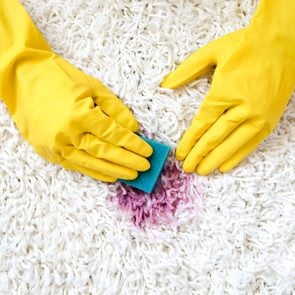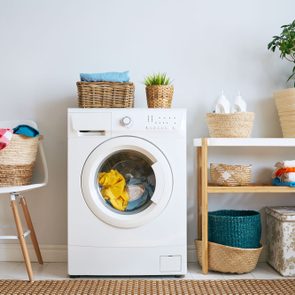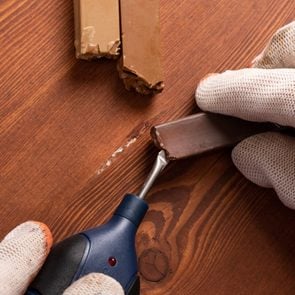How to Clean Tile Floors Quickly and Easily
Updated: Jun. 02, 2024

No matter the type of tile you have in your home, these expert tips on how to clean tile floors will extend their lifespan
Our editors and experts handpick every product we feature. We may earn a commission from your purchases.Learn more.
Tile flooring offers homeowners a huge range of materials, pricing and designs to choose from. And one thing most tile has in common is just how easy it is to maintain. Because tile doesn’t generally require a lot of upkeep and can tolerate moisture and messes, learning how to clean tile floors tends to be far simpler than cleaning hardwood floors or cleaning marble floors. And that means adding tile cleaning to your cleaning schedule is a breeze.
If you’ve learned how to clean a bathroom and how to clean your kitchen properly, you likely know that regular floor cleaning in these spaces is vital to keep them free of dirt, germs and bacteria. “Just cleaning something doesn’t disinfect it,” says Liz Trotter, owner of American Maid Service in Olympia, Washington. One result of the COVID-19 pandemic is that more people actually understand how to clean and how to disinfect, she says.
Luckily, learning how to clean tile floors isn’t very complicated, as long as you know the type of tile you have installed and the proper way to mop. For most people, Trotter says, the toughest part of tile cleaning is actually cleaning the grout. Floors are an investment in your home, and the payoff for proper cleaning is not only a sparkling tile floor, says Trotter, but also a longer-lasting one. Here are some step-by-step instructions for the most efficient tile cleaning.
How often should you clean tile floors?
A big part in learning how to clean tile floors is knowing how often to do so. This depends on several factors, including how many people live in the home, whether there are pets and how much foot traffic the room sees. In general, cleaning professionals recommend cleaning tile floors (including vacuuming and mopping) once a week. Less frequent cleanings in moist environments like bathrooms can encourage mold and mildew to grow. It’s also advised that you hire a professional to deep-clean your grout and re-seal it every year or two.
Does the type of tile affect how you clean it?
One of the tricky things about tile is that it encompasses many different materials, and the type of tile does impact how you clean it. Tile floors can be made of ceramic, porcelain or natural stone, and the specific material will determine what products you use. Using the wrong tile floor cleaner can actually damage your floors over time.
While harsh and acidic cleaners like bleach and white vinegar are most often a concern with natural stone, they also shouldn’t be used on most tile. Many people believe these products are necessary to clean mildew and mold from ceramic and porcelain tile, but even the most durable materials can react badly with regular use of acidic cleansers. When used often in high concentrations without being rinsed away, bleach and vinegar can erode sealants that protect tile and grout, allowing soap, dirt and oil to penetrate it, according to the Tile Council of North America. That’s why most cleaning experts will recommend a pH-neutral floor cleaner. “That’s the beauty of a neutral pH product,” says Pam Clyde, owner of BritLin Cleaning in Round Rock, Texas. “It can be used on every kind of floor.”
How to clean porcelain and ceramic tiles
Porcelain and ceramic tiles are known for their durability and water resistance. Look for a tile floor cleaner with a neutral pH, which will be stated on the label. If you’re unsure about whether a product is safe to use, Clyde suggests looking up the safety data sheet, which is required for every cleaning product. These informational sheets list the product’s pH, and a pH of 7.0 is neutral.
Prepare the cleaning product according to the manufacturer’s instructions, and don’t worry about over-diluting it, says Trotter. “Water applied correctly will do a better job at cleaning than a floor product applied incorrectly,” she says. “You want to use the least amount of volume and leave it on for the least amount of time possible.”
Supplies:
- Canister vacuum
- Microfiber mop
- Extra microfiber pads (several, depending on the size of the floor)
- Zep Neutral pH Floor Cleaner
- Black Diamond Marble & Tile Concentrated Cleaner
- Cleaning bucket
Directions:
- Choose your most dependable vacuum and vacuum the area to remove any dirt and debris.
- Prepare the cleaning solution according to the manufacturer’s instructions. If you have never used it on the tile before, test the solution on an inconspicuous area to make sure it won’t damage the tile.
- Soak several microfiber mop pads in the cleaning solution and wring them out so they’re damp but not dripping.
- Start at the farthest point away from you and work in one section of the floor at a time. Trotter says that rather than cleaning in the same order and direction, mop first in one direction, then turn 90 degrees to make sure you get all the crevices and crannies.
- Move the mop in an S-shaped pattern, rotating the mop head at each curve so you are always moving any dirt or debris forward, not simply pushing it back and forth.
- Repeat until the entire floor is clean. Change mop pads regularly, as they get dirty.
- Clean grout last (see below).
How to clean natural stone tiles

If you’ve ever had to clean marble countertops, then you already know that natural stone needs a little extra TLC. It’s vital to use a neutral pH floor cleaner, because many kinds of natural stone contain calcite, a mineral that reacts strongly with anything slightly acidic, including household cleaners like ammonia and white vinegar. Using acidic cleaners on natural stone floors can eat away at the stone and leave permanent dull spots known as etching.
The other major difference between cleaning natural stone tile and ceramic tile is that you’ll need to dry the natural stone tile to avoid unsightly streaks. If possible, use two microfiber mops, one wet and one dry, or use a dry microfiber cloth to dry the floor.
Supplies:
- Canister vacuum
- Microfiber mop(s)
- Extra microfiber pads (several, depending on the size of the floor)
- Microfiber cloths
- Black Diamond Marble & Tile Concentrated Cleaner
- Cleaning bucket
Directions:
- Vacuum the area to remove any dirt and debris. Keep in mind that some vacuums can actually scratch natural stone, so be careful about the machine you use. The Miele Boost Vacuum is a good option, because its natural, gentle brush won’t scratch surfaces.
- Prepare the natural stone cleaning product as stated on the product package. Keep in mind that it may need to be diluted. If you have never used it on your tile before, test the solution on an inconspicuous area to make sure it won’t damage the tile.
- Dip a microfiber mop in the cleaning solution and wring it out so it’s wet but not dripping.
- Start at the farthest point away from you and work in one small section at a time.
- Start in one corner and move the mop in an S-shaped pattern, rotating the mop head at each curve so that you are always moving any dirt or debris forward, not simply pushing it back and forth.
- After completing a section, use a dry microfiber mop or dry microfiber cloth in the same pattern to dry the floor. This prevents streaking.
- Repeat until the entire floor is clean.
- Change your mop pads and rinse your water at regular intervals.
- Use a gentle sponge to scrub the grout last and wipe it dry afterward with a clean, dry microfiber cloth.
How to clean grout
Similar to removing hard-water stains or cleaning that pink slime in your shower, learning how to clean grout can seem like an overwhelming task. Grout can be epoxy- or cement-based, and the former is easier to clean. Cement-based grouts will have a grittier texture and can be dissolved by acids, so it’s best to use a neutral pH grout cleaner, according to the Tile Council. That means no vinegar or bleach. The Tile Council also advises against using oil- or wax-based cleaners, which can be absorbed by the grout, resulting in discoloration or a film on top of the grout.
“There are special grout brushes that are angled on a stick to make it easy to scrub,” Clyde says. Do this step when you’re cleaning your showerhead or cleaning your glass shower doors. Apply the cleaner of your choice, brush gently, rinse thoroughly, and you’ll have like-new grout lines.
Supplies:
- Scotch-Brite Grout & Detail Brush
- OXO Good Grips Brush Set
- Black Diamond Ultimate Grout Cleaner
- StoneTech Stone & Tile Cleaner
- Bissell vacuum-mop combo
- Bucket
- Microfiber cloths
Directions:
- After cleaning the tiles, either choose the same pH-neutral cleaning agent you used for the tiles or a product designed for grout, like this TikTok-favorite grout cleaner. Spray the grout brush with the solution.
- Gently scrub the grout lines with the brush and rinse with clean water.
- If you have a vacuum-mop combo, suction up any remaining water. If you don’t, rinse thoroughly with clean water and wipe up any excess water with a microfiber cloth.
- Stubborn grout stains can be treated with steam, or in extreme cases, the grout can be removed and replaced. It is recommended that a professional do this kind of work.
The best tile cleaners
How to keep tile floors clean
For the most part, learning how to clean tile floors can go a long way toward keeping your flooring in good shape. But avoiding dirt from accumulating on your floors in the first place can be almost as valuable. When it comes to porcelain and ceramic tile, both materials are extremely durable and low-maintenance. Using floor mats where possible and vacuuming regularly can help prevent dirt and debris from collecting. You can also take tips from professional organizers, who use shoe storage solutions to keep dirty shoes from walking past the entryway. If the tile flooring is used in bathrooms, making sure those rooms have proper airflow can also help prevent mildew and mold from forming.
While ceramic and porcelain tile are more stain-resistant than natural stone, it’s still a good idea to wipe up spills quickly, especially if the liquid that spilled is even slightly acidic. Grout can be susceptible to damage from acidic spills and should be sealed every one to three years, depending on how much wear and tear it gets. By taking these precautions and cleaning tile properly, you can have beautiful, clean floors that will last the lifetime of your home.
Sources:
- Tile Council of North America
- Pam Clyde, owner of BritLin Cleaning
- Liz Trotter, owner of American Maid Service


























